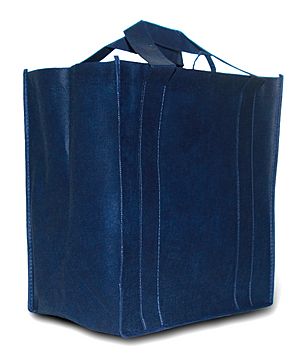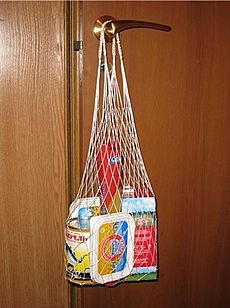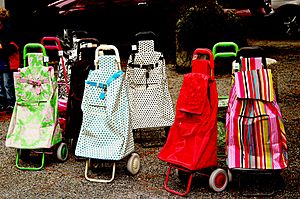Reusable shopping bag facts for kids
A reusable shopping bag is a special type of shopping bag that you can use over and over again. Unlike single-use paper or plastic shopping bags, these bags are made to last. They are often like a tote bag made from strong materials. These materials can be fabric like canvas, natural fibers such as jute, or thick, woven plastic.
Some people also use a string bag or a wheeled trolley bag for their shopping. You can usually buy reusable bags at supermarkets and clothing stores.
Making reusable bags uses more energy than making regular plastic bags. For a reusable bag to be better for the environment, you need to use it many times. Some studies show you might need to use a cotton bag over 100 times before it helps the environment more than single-use plastic bags.
Contents
How Reusable Bags Became Popular
Reusable Bags in the United States
Plastic shopping bags first became popular in the US in 1977. They quickly replaced paper bags in grocery stores during the 1980s and 1990s. Later, in the 1990s, some governments started adding taxes on disposable plastic bags. They also began making rules about how these bags could be used.
Many supermarkets started encouraging shoppers to use reusable bags. They did this by selling inexpensive reusable bags. They also shared information about how plastic bags can harm the environment. The design of reusable bags often looks different from the old plastic bags. The fashion world also promotes reusable bags as a way to be more eco-friendly.
Stores often sell reusable bags to increase their sales. These bags cost very little to make, but they are sold for a higher price. Some large supermarkets sell bags made of string or calico. They often promote these bags by talking about environmental issues. The designs on these bags might show nature, like trees or the Earth. This helps remind people about protecting our planet.
Some supermarkets even have reward programs for customers who bring their own bags. When customers collect enough points, they can get discounts or gifts. This encourages more people to reduce their plastic bag use. Stores like Whole Foods Market and Target might even give you a small cash discount for bringing your own reusable bag.
Even with these efforts, most US grocery shoppers still do not bring their own bags. Many reusable bags that are bought are not used very often.
Reusable Bags in the United Kingdom
Most British supermarkets offer reusable shopping bags. These bags are usually sold for a small price, like 10 pence. If they break, the store will often replace them for free. These bags are much stronger than regular plastic bags, so you can use them many times.
The main reason for these bags is to help meet rules about packaging waste. They also encourage people to recycle the bags. Unlike the 5p carrier bags, there is a small reason to bring these bags back for recycling. This helps reduce their impact on the environment.
Reusable "bags for life" are often colorful and show the supermarket's advertising. Some stores keep the same design for years. Others, like Waitrose, change their designs with the seasons or new ad campaigns. Waitrose was the first British Supermarket to launch the "Bag For Life" in 1998. They even turn broken bags into black benches placed outside their stores.
In 2015, the UK Government added a tax on all carrier bags. This meant customers had to pay 5p for any carrier bag from large stores.
More and more people are using jute and juco bags. Juco is a mix of cotton and jute. These natural bags are a good choice instead of single-use plastic or reusable plastic bags. They are sold in many major supermarkets. These bags can last for 3-4 years. If used correctly, one jute bag can replace over 600 single-use bags. When they are no longer useful for shopping, they can even be used to grow vegetables!
Reusable Bags in Other Countries
In Ireland, reusable bags became popular in March 2002. This was when the Plastic Bag Environmental Levy was introduced. This tax helped reduce the huge number of disposable bags used each year. Bags that cost 70 euro cents or more are not included in this tax.
In Australia, these bags are often called green bags. This is because they are better for the environment and are often green. They are usually given out at stores. They are meant to be used many times to replace hundreds of High-density polyethylene (HDPE) plastic bags. Most green bags are made of a material called Non-woven Polypropylene (NWPP). This material can be recycled but does not break down naturally.
Keeping Reusable Bags Clean and Safe
Food Safety Concerns
Many people do not wash their reusable bags after shopping. This can sometimes lead to food poisoning. Dr. Richard Summerbell, a research director, noted that bags can pick up germs from raw meats and vegetables. This increases the risk of foodborne illness.
One study found that some reusable bags had high levels of mold and bacteria. These levels were much higher than what is considered safe in drinking water. Another study in 2010 found that many reusable bags had bacteria like coliform. This type of bacteria is found in waste. The study also found E. coli in some bags.
To keep bags safe, experts suggest:
- Bags should have instructions telling people to clean them regularly.
- People should be taught about the risks and how to prevent them.
- Always keep raw foods separate from other foods in your bag.
- Do not use reusable food bags for other things, like carrying gym clothes.
- Avoid leaving bags with food in hot places, like a car trunk. Heat helps bacteria grow.
The good news is that washing reusable bags, even without bleach, can greatly reduce bacteria. A magazine called Consumer Reports also said that the amount of bacteria found in some studies might not be as dangerous as it sounds. They still recommend being careful with raw meat and fish. It's always a good idea to wash your reusable bags from time to time.
Product Safety Concerns
In 2010, some reusable shopping bags were found to have high levels of lead. This led to recalls by several stores. For example, Wegmans Food Markets replaced some of their bags. Winn-Dixie also recalled their bags after an investigation.
In Canada, athletic retailer Lululemon Athletica recalled their bags in 2009. Sears in Canada also recalled bags in 2011 for similar reasons. Disney-themed bags sold at Safeway in the US were also found to have high lead levels. Safeway recalled these bags in early 2011.
Lead can be harmful, especially to children. Because of these findings, many groups called for investigations into the safety of reusable bags. It's important for companies to make sure their products are safe for everyone.
Besides lead, there are also concerns about bacteria if bags are not washed often. In 2012, a study linked a norovirus outbreak to a reusable grocery bag. This happened when a girls' soccer team shared cookies from the bag.
Rules and Laws for Reusable Bags
Some governments have made rules to encourage or require the use of reusable shopping bags. They do this by banning plastic bags, requiring recycling, or adding taxes or fees. Laws to reduce plastic bag use have been passed in places like Hong Kong, Ireland, South Africa, the United States, Canada, and Taiwan.
In 2002, the Australian government looked into using disposable plastic bags. They even said they might ban them if stores didn't try to reduce their use. This led to stores promoting "Green Bags" more widely.
Since October 2011, the government in Wales has required a minimum tax of 5p on single-use carrier bags. In 2012, San Luis Obispo County, CA, banned disposable plastic bags. Shoppers there now have to bring their own bags or pay 10 cents for a paper bag. In 2009, Washington, D.C. started charging 5¢ for each disposable bag.
Reusable Bags as a Fashion Trend
Because governments and supermarkets encourage reusable bags, they have become a new fashion trend. The clothing industry has also helped make it cool to have stylish reusable shopping bags instead of plastic ones.
In 2007, British designer Anya Hindmarch created a $15 "I'm Not A Plastic Bag" cotton bag. It sold out in one day and was later sold online for much more money! Brands like Envirosax started by making reusable shopping bags. Now, they offer many colors and patterns. They even have bags with characters like those from Sesame Street.
In Germany, old-fashioned "Grandma's shopping net" bags have become popular again. This is due to environmental concerns and a love for retro styles. The DDR Museum in Berlin even has a collection of these bags. They are now often sold as "East German cult classics."
Studies show that people who buy organic food or treats like ice cream are more likely to use reusable bags.
Types of Reusable Bags
| Type | Can it break down naturally? | Does it fight germs? | Does it keep things cold or hot? |
|---|---|---|---|
| Jute | Yes | No | No |
| Hemp | Yes | Yes | No |
| Synthetic Textiles | No | Yes | No |
| Nonwoven fabric, Tyvek, etc. | No | Yes | No |
How Reusable Bags Are Tested
There are ways to check if reusable shopping bags are truly strong enough to be reused many times. One way is to use a special test in a lab. Bags are loaded with 10 kg (22 lb) of weight. Then, they go through different tests that involve pulling and stretching.
Other tests involve people carrying bags with 10 kg (22 lb) of items for about 50 meters (175 feet). This is repeated many times. The bags are also washed regularly during these tests to see how they hold up.
Images for kids
-
A non-woven polypropylene "green bag" from Australia
See also
 In Spanish: Bolsa reutilizable para niños
In Spanish: Bolsa reutilizable para niños





